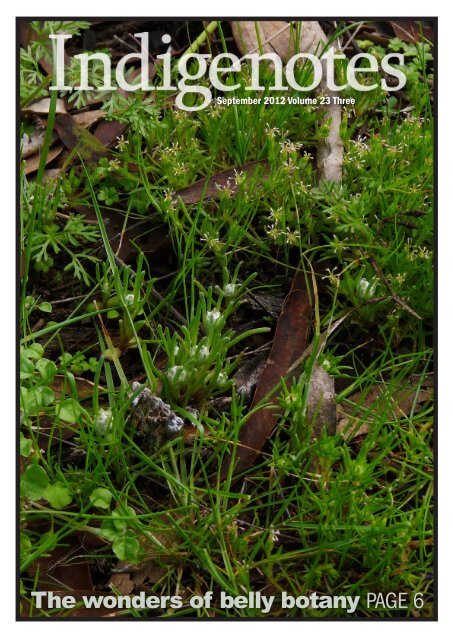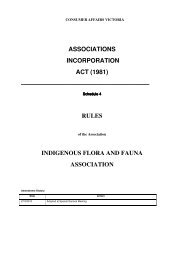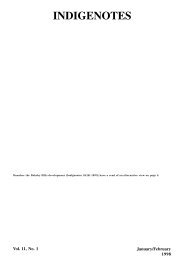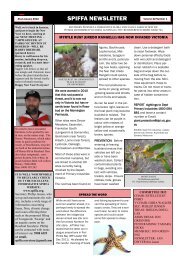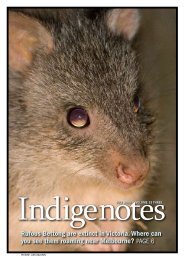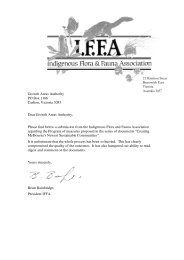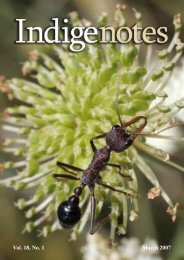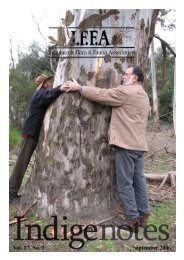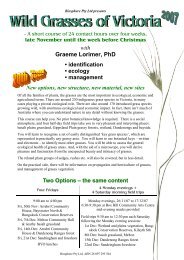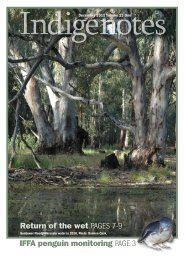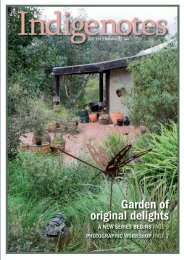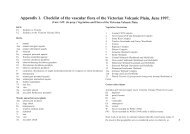Indigenotes - Indigenous Flora and Fauna Association
Indigenotes - Indigenous Flora and Fauna Association
Indigenotes - Indigenous Flora and Fauna Association
Create successful ePaper yourself
Turn your PDF publications into a flip-book with our unique Google optimized e-Paper software.
September 2012 Volume 23 Three<br />
The INDIGENOTES VOLUME wonders 23 NUMBER 3 of belly botany PAGE 6
Presidents letter<br />
Places you love<br />
A<br />
new campaign urges us to make our voice heard for biodiversity<br />
conservation. The Places You Love campaign is being run by an alliance of<br />
conservation groups. It aims to counter a corporate-led attack on Australia’s<br />
conservation laws.<br />
At the Council of Australian Governments (COAG) meeting of state <strong>and</strong><br />
federal governments earlier this year, business had special access through the<br />
COAG ‘Business Advisory Forum’. This unprecedented access was granted to<br />
no other sector of Australian civil society. The business lobbies’ clamour to slash<br />
environmental protection found a willing ear among many governments. They<br />
were quick to adopt the belittling label ‘green tape’ to describe environmental<br />
laws. On 13 April 2012, COAG announced its intention to ‘streamline’ both<br />
federal <strong>and</strong> state environmental laws across Australia with a particular emphasis<br />
on environmental assessment processes. This effectively h<strong>and</strong>s state <strong>and</strong> territory<br />
governments the power to assess <strong>and</strong> approve projects in their state, removing<br />
the federal government’s current <strong>and</strong> very important oversight role. In particular,<br />
there is an intention to nobble the Environment Protection <strong>and</strong> Biodiversity<br />
Conservation Act 1999 (the EPBC Act) which has seriously advanced conservation<br />
in this country over the last decade.<br />
Imperfect as they are, our environmental laws have provided brakes to our<br />
nation’s hurtling race to destroy nature. I have witnessed many instances where<br />
Federal laws have had more ‘teeth’ than State legislation <strong>and</strong> have been critical<br />
to conservation victories. The Places You Love campaign is providing a means to<br />
collectively express our very clear support for these laws. The IFFA committee<br />
supports the aims of the conservation group alliance <strong>and</strong> this initiative.<br />
I urge members to become informed, add your voice <strong>and</strong> spread the word about<br />
this campaign. At the website below you can upload photos of places you want to<br />
protect <strong>and</strong> find templates for letters to send to your local members <strong>and</strong> the PM.<br />
Don’t be silent, nature needs your voice.<br />
http://placesyoulove.org/<br />
IFFA & SPIFFA<br />
OUTING<br />
Cranbourne<br />
Botanic Gardens<br />
27th October 11am<br />
Join our Southern Peninsula IFFA brethren<br />
for a heathl<strong>and</strong> walk <strong>and</strong> lunch at<br />
Cranbourne Botanic Gardens.<br />
Meet at 11am in the Stringybark Picnic<br />
Area (Melways map 133K12) for a walk<br />
through the heathl<strong>and</strong>s at the site.<br />
We will lunch at around 1pm.<br />
Those who are interested can then either<br />
do a walk in another part of the<br />
heathl<strong>and</strong> or go to the formal part of the<br />
gardens for the Australian Garden walk at<br />
around 2pm.”<br />
Bookings are not required, but inquiries<br />
can be made to Fam Charko on<br />
0402519124, or bookings@iffa.org.au.<br />
IFFA’s trip to Nardoo Hills was a great<br />
success, <strong>and</strong> will be written up for the<br />
next issue of <strong>Indigenotes</strong>.<br />
Review<br />
Life in a gall. The biology <strong>and</strong> ecology of insects that live in plant galls.<br />
Rosalind Blanche. CSIRO Publishing 2012, 70 pages<br />
When walking in the bush with others, I am frequently asked about the lumps,<br />
bumps <strong>and</strong> miniature sculptures that adorn our gums <strong>and</strong> wattles <strong>and</strong> other plants.<br />
Up till now, I have only been able to answer questions in general terms, aware I was<br />
missing out on a world of stories hidden within these galls. In my garden, one kind<br />
of Gall-wasp helps by pollinating delicious figs while the Citrus Gall Wasp deprives<br />
me of lemons<br />
Rosalind Blanche’s slender book is a perfect introduction to this fascinating<br />
world. The range of different invertebrates (as well as fungi, viruses,<br />
nematode worms <strong>and</strong> others) that creates galls was a revelation.<br />
Examples of the diverse life cycles <strong>and</strong> ecologies inside these structures<br />
are efficiently related in the easy to underst<strong>and</strong> <strong>and</strong> copiously illustrated<br />
text. I was particularly struck by the social life of gall-forming thrips<br />
which form miniature hives<br />
The galls’ effect on native plants used in commerce was another<br />
interesting story – with studies on the local ecology of galls used to<br />
design biological control program overseas. Blanche completes this book<br />
with a practical chapter on how you can study galls for yourself <strong>and</strong> the<br />
inspiring story of a Canberra primary School project that contributed to<br />
the discovery <strong>and</strong> naming of a wasp with a unique gall lifecycle.<br />
I heartily recommend this book to both the beginner <strong>and</strong> experienced<br />
amateur naturalist alike, it shows there is a whole realm of intriguing<br />
complexity waiting to be found in any bushl<strong>and</strong> or backyard.<br />
Reviewed by Brian Bainbridge.<br />
2<br />
INDIGENOUS FLORA AND FAUNA ASSOCIATION INC
Dingy Swallowtail or<br />
Small Citrus Butterfly,<br />
Papilio anactus.<br />
Mick Connolly<br />
utterflies <strong>and</strong> habitat restoration<br />
What sets a lepidopteran heart aflutter? What sort of gr<strong>and</strong> design<br />
builds into butterfly habitat? The simple planting of lom<strong>and</strong>ra is not<br />
enough, explains Ian Faithfull<br />
John Reid’s article in <strong>Indigenotes</strong> 23:2 concentrates on<br />
the particular food plants of butterfly species, <strong>and</strong> advocates<br />
their establishment as a method of conserving <strong>and</strong> restoring<br />
butterfly populations. Although such plantings are a fundamental<br />
requirement, this is an oversimplified approach since butterflies,<br />
like other animals, require much more than food.<br />
Yen (2011 p. 205) summarised the situation this way: “In<br />
most cases, there is an emphasis on recreating pre-European<br />
settlement habitats .. . <strong>and</strong> [this] often only involves planting<br />
known food plants, especially of butterflies, in the hope that<br />
they will be colonised.”<br />
Historical records<br />
Firstly, as Braby (1989) remarked, there were at that time<br />
few studies that provided a reasonably complete picture of the<br />
butterfly fauna of any specific region or habitat in Victoria. Little<br />
has subsequently changed. Published historical information on<br />
the Melbourne fauna is scarce <strong>and</strong> consists mostly of isolated<br />
records of species of particular interest because of their rarity,<br />
abundance, unseasonal occurrence, etc. There are few published<br />
accounts of the faunas in particular areas of Melbourne. Examples<br />
include the fauna of LaTrobe University (Braby 1989), Yarra<br />
Bend (Faithfull 1992) <strong>and</strong> Wattle Park, Burwood (Braby <strong>and</strong><br />
Berg 1987 1989, Faithfull 1989 1993). Accounts may appear in<br />
local newsletters, ecological survey reports etc. but these tend to<br />
be even less accessible.<br />
The Dunn <strong>and</strong> Dunn (2006) butterfly database has good<br />
Victorian coverage <strong>and</strong> enables compilation of faunas for<br />
particular areas based on actual distribution point records,<br />
however information is not available for many localities in<br />
the Melbourne area. In contrast, the maps in Braby (2000)<br />
generally extrapolate the range of a species to cover areas<br />
between known distribution points <strong>and</strong> thus may be grossly<br />
misleading if used to assemble a species list for a particular<br />
locality. The Atlas of Victorian Wildlife <strong>and</strong> Museum of<br />
Victoria databases also contain butterfly records <strong>and</strong> should be<br />
consulted if seeking to compile local area information. Lack of<br />
adequate historical documentation of the local fauna means the<br />
effects of restoration efforts cannot be objectively assessed <strong>and</strong><br />
there appears to be little evidence that restoration plantings<br />
or butterfly gardening in the Melbourne region have had any<br />
butterfly conservation benefits. Tons of Lom<strong>and</strong>ra longifolia<br />
have been planted, but I am floundering to come up with any<br />
documentation of its utilisation.<br />
Flavours in favour<br />
Secondly, current underst<strong>and</strong>ings of known food plants of<br />
a butterfly species are incomplete <strong>and</strong> knowledge continues to<br />
exp<strong>and</strong>. According to Common <strong>and</strong> Waterhouse (1981) the<br />
food plants of the Australian Admiral, Vanessa itea, on mainl<strong>and</strong><br />
Australia were species of Urtica (stinging nettles), but the food<br />
plant list now includes two Parietaria species (Braby 2000).<br />
INDIGENOTES VOLUME 23 NUMBER 3 3
Butterflies <strong>and</strong> habitat restoration Continued from page 3<br />
It may well be the plant species assumed to be a host in<br />
a particular area is not a host, <strong>and</strong> in some cases the actual<br />
favoured host may await discovery. In many cases with<br />
Melbourne butterflies, the actual hosts are exotic species,<br />
e.g. Ehrharta erecta is commonly utilised by the Common<br />
Brown, Heteronympha merope, in Melbourne (Braby<br />
2000). Melbourne is probably very similar to the City of<br />
Davis, California, where non-indigenous food plants, both<br />
cultivated <strong>and</strong> naturalised are very important for the diverse,<br />
highly valued butterfly fauna, so much so the objectives of<br />
butterfly conservationists conflict with those of plant-focused<br />
restorationists <strong>and</strong> weed controllers (Shapiro 2002).<br />
Habitat <strong>and</strong> microhabitat<br />
Thirdly, as any entomologist will attest, patches of<br />
apparently suitable food plants are usually not inhabited. The<br />
precise factors that make for good habitat are generally poorly<br />
known. Breeding populations may shift from habitat patch<br />
to habitat patch, or remain in one<br />
habitat patch for many years without<br />
neighbouring patches being colonised.<br />
Many other factors beside the<br />
presence of the food plant determine<br />
the suitability of the habitat for a<br />
particular butterfly species. Many of<br />
the blues (Lycaenidae) have symbiotic<br />
relationships with ants, which protect <strong>and</strong> guard larvae <strong>and</strong><br />
pupae. Eggs may not be laid if ants of the appropriate taxa<br />
are not present, or if laid, the larvae may be exterminated by<br />
predators without ants to guard them.<br />
Suitable temperatures (often measured as accumulated<br />
‘degree-days’) are very important for the development of<br />
the juvenile stages of Lepidoptera. In particular the extent<br />
to which the plants are exposed to sunlight has differential<br />
importance for different species.<br />
Food plants in shaded positions at a particular time of day<br />
in a particular season may never be colonised because the<br />
fertilised adult female won’t fly there. The larval webs of Delias<br />
harpalyce are almost always on the sunny side of a mistletoe<br />
clump, <strong>and</strong> Ogyris species pupate under the bark on the sunny<br />
side of a tree (K. Dunn, pers. comm.), so mistletoes in shaded<br />
areas are less likely to be successfully utilised.<br />
With other butterfly species, like the grass-feeding<br />
Heteronympha merope, shade of some type appears to be<br />
necessary: open grassl<strong>and</strong>s are just not suitable for it.<br />
Moisture conditions are also important, both for plant<br />
growth, since larvae usually require fresh, palatable food during<br />
their development, <strong>and</strong> because excessive humidity or dryness<br />
will have adverse effects on survival of juvenile stages.<br />
Food plants may be rejected if their foliage contains<br />
inadequate levels of essential nutrients, or particular<br />
biochemical constituents that might be characteristic of<br />
varieties of a plant species that are oviposition deterrents or<br />
toxic to larvae. Adult butterflies require nectar, <strong>and</strong> often feed<br />
on other liquids such as fluids in puddles, dung, tree sap,<br />
etc. If suitable adult food <strong>and</strong> watering requirements are not<br />
present in the vicinity of a planting then colonisation will be<br />
unlikely.<br />
Adult butterflies utilise flight spaces <strong>and</strong> perches that tend to<br />
be species specific. For example, a male butterfly may require a<br />
suitable open area in a particular height range to patrol if it is<br />
to remain in the area.<br />
Many butterflies require areas of bare ground on which to<br />
bask, so over-thorough revegetation that fills all the spaces can<br />
be detrimental to them.<br />
The importance of microhabitats is generally poorly<br />
understood, as are a range of other habitat factors. Many<br />
skipper butterflies (Hesperiidae), for example, oviposit not<br />
on the host itself but on leaf litter near the food plant (Braby<br />
2000), so absence of such litter might preclude establishment.<br />
Some species often pupate off the food plant, e.g. under the<br />
bark of nearby trees, so restoration efforts must take this into<br />
consideration.<br />
Factors such as chemical pollution, artificial lights <strong>and</strong><br />
anthropic noise levels may well have an impact. Disruptive<br />
wind patterns such as those produced by vehicle traffic along<br />
major roads possibly disrupt butterflies sufficiently to preclude<br />
their establishment in roadside plantings.<br />
Patches of apparently suitable food plants are usually not<br />
inhabited . . . Breeding populations may shift from habitat<br />
patch to habitat patch, or remain in one habitat patch for<br />
many years without neighbouring patches being colonised.<br />
The role of predators <strong>and</strong> parasites in the limitation of<br />
butterfly populations is poorly understood, but it seems likely<br />
that in some areas the presence of a particular predator (e.g.<br />
an exotic ant species) could prejudice the survival of juvenile<br />
butterfly populations.<br />
Recolonisation <strong>and</strong> reintroduction<br />
Finally, the food plants must be found by adult female<br />
butterflies in order to be colonised. Since many species<br />
disperse poorly, that may never happen once a butterfly species<br />
has disappeared from an area.<br />
What constitutes a suitable dispersal corridor for nonmigrant<br />
butterflies has generally never been established for<br />
Victorian species. Adults of the Swordgrass Brown, Tisiphone<br />
abeona, seem rarely to venture far into open areas <strong>and</strong> may<br />
require continuous canopy at least 2 m high with plenty of<br />
flight space beneath. Reintroductions of butterflies (this is<br />
usually effective only with juvenile stages) may be required, but<br />
such translocations have various potential problems, similar to<br />
those with which most readers will be familiar in the context<br />
of plants, such as the risk of genetic pollution if provenances<br />
are not understood, <strong>and</strong> the choice of an unsuitable ecotype<br />
for introduction.<br />
Monitoring <strong>and</strong> documentation<br />
So there is a need to document <strong>and</strong> publish local area<br />
butterfly species lists <strong>and</strong> known local food plants, with<br />
details of the condition of the vegetation during the period of<br />
observations. This at least will enable some future assessment<br />
of the success of plantings in regard to butterfly diversity.<br />
Where revegetation programs are believed to have been<br />
successful at providing habitat for butterflies this information<br />
needs to be recorded <strong>and</strong> compiled. Casual records of<br />
single or a few species will be difficult to publish but could<br />
be submitted to the Atlas of Victorian Wildlife or may be<br />
4<br />
INDIGENOUS FLORA AND FAUNA ASSOCIATION INC
Review<br />
Intelligent Tinkering<br />
Bridging the gap between Science <strong>and</strong> Practice<br />
Robert J. Cabin<br />
Society for Ecological Restoration<br />
Isl<strong>and</strong> Press, Washington<br />
Distributed in Australia by CSIRO Publishing<br />
‘Intelligent tinkering’ was the term used by the famous<br />
ecologist, Aldo Leopold, over sixty years ago to describe his<br />
explorations into restoration of degraded prairie l<strong>and</strong>. The<br />
casual approach this term suggests is still the dominant<br />
mode of knowledge-building among ecological restoration<br />
practitioners.<br />
Cabin, a trained ecologist, explains how scientists are often<br />
frustrated by practitioner’s perceived reluctance to employ formal<br />
scientific processes. Cabin has also experienced practitioner’s<br />
disgust at collaborations with scientists that result in findings they<br />
regard as obvious or irrelevant.<br />
In this thought-provoking book, Cabin has attempted to unravel<br />
the issues that underlie this problem. These range from the<br />
self-evident to deep philosophical divides. Cabin explains that<br />
classic science investigations attempt to prove general rules, while<br />
locally developed projects are concerned with site peculiarities. In<br />
many cases this means investigations critical to the practitioner<br />
are of no interest to a scientist <strong>and</strong> vice versa. Thus scientists<br />
become perceived as out-of-touch<br />
<strong>and</strong> practitioners <strong>and</strong> their work<br />
are dismissed as ‘un-scientific’<br />
<strong>and</strong> a hindrance to ‘doing things<br />
right’. This is disastrous for projects<br />
based on collaboration <strong>and</strong> Cabin’s<br />
book is a plea for scientists <strong>and</strong><br />
practitioners to find common<br />
ground <strong>and</strong> respect for each other’s<br />
strengths.<br />
Cabin’s book is illustrated by his<br />
fascinating work in the restoration<br />
of a ‘basket-case’ ecosystem; the<br />
dry forests of Hawaii. National <strong>and</strong> cultural peculiarities are<br />
occasionally apparent but the joys <strong>and</strong> frustrations will be familiar<br />
to many in Australian restoration projects. Among minor quibbles,<br />
I occasionally felt that Cabin under-estimated the scientific basis<br />
of the intuition <strong>and</strong> ‘art’ of practitioners.<br />
While the problem this book addresses may seem very specific,<br />
it h<strong>and</strong>icaps progress of thous<strong>and</strong>s of projects to conserve our<br />
biodiversity. Professionals, volunteers <strong>and</strong> academics seeking to<br />
combine their efforts will benefit from the variety of perspectives<br />
that Cabin brings to light.<br />
Brian Bainbridge<br />
Butterflies <strong>and</strong> habitat restoration Continued from page 4<br />
acceptable to K.L. Dunn for the Dunn <strong>and</strong> Dunn butterfly<br />
database (which is operated entirely without government<br />
support). The Victorian Entomologist (Entomological Society of<br />
Victoria) is the most active purveyor of butterfly information<br />
in Victoria <strong>and</strong> may be an option for publishing more detailed<br />
information <strong>and</strong> species lists. What is really needed are modern<br />
Wiki databases that enable the build-up of information by<br />
multiple observers over time. However such systems tend to<br />
have quality control issues (notably unreliable observers <strong>and</strong><br />
incorrect species identifications) if not strictly overseen. In<br />
all cases the minimal information that should be recorded<br />
includes the date <strong>and</strong> time of the observation, the locality <strong>and</strong><br />
GPS reading, the butterfly species <strong>and</strong> life stage, the number of<br />
individuals <strong>and</strong> the details of the habitat.<br />
Long term biodiversity monitoring requires dedication, since<br />
it is not going to be paid for by governments. Ideally what<br />
is required is more than casual observation. Transect or belt<br />
surveys, where the numbers of individual butterfly adults seen<br />
along a defined transect are counted by experienced observers,<br />
are a good method to establish baseline data for a site. Regular<br />
repetition of a survey over a number of years (pre to postreveg)<br />
should enable an assessment to be made of the effects<br />
of the restoration efforts on butterflies. But bear in mind<br />
that some species may require more specialised monitoring<br />
techniques. When planning or undertaking revegetation<br />
work, the particular contexts of the plantings — the other<br />
butterfly habitat factors — need at least to be considered in<br />
terms of what is known about a particular butterfly species’<br />
requirements. It is worth stressing the survival of a particular<br />
butterfly species in a particular locality might possibly be<br />
prejudiced by zealous weed eradication programs or other<br />
features of the rehabilitation program. As is the case with spiny<br />
weeds <strong>and</strong> small birds, one needs to establish suitable native<br />
habitat plants before eradication takes place.<br />
And finally, much more needs to be known about the<br />
peculiar habitat requirements of butterfly species before a<br />
meaningful prediction can be made about whether a particular<br />
planting will be beneficial. Revegetation efforts that fail to<br />
result in butterfly establishment thus have the potential to yield<br />
lessons for future activity.<br />
References<br />
Braby, M.F. (2000) Butterflies of Australia. Their Identification,<br />
Biology <strong>and</strong> Distribution. CSIRO, Collingwood.<br />
Braby, M.F. & Berg, G.N. (1987) A preliminary search for Trapezites<br />
symmomus Hubner at Wattle Park, with notes on other species.<br />
Victorian Entomologist 17, 49-51.<br />
Braby, M.F. & Berg, G.N. (1989). Further notes on butterflies at<br />
Wattle Park, Burwood. Victorian Entomologist 19, 38-42.<br />
Braby, M.F. (1989) The butterfly fauna of La Trobe University, Victoria.<br />
Victorian Naturalist 106,118-132.<br />
Common, I.F.B. <strong>and</strong> Waterhouse, D.F. (1981) Butterflies of Australia.<br />
Revised Edn., Angus & Robertson, Sydney.<br />
Dunn, K.L. <strong>and</strong> Dunn, L.E. (2006) Review of Australian Butterflies<br />
1991. Annotated Version. (CD-ROM), K.L. & L.E. Dunn, Melbourne.<br />
Faithfull, I. (1989) Two additional Wattle Park butterflies.<br />
Victorian Entomologist 19(5), 86.<br />
Faithfull, I. (1992) Butterflies at Yarra Bend 1983-90.<br />
Victorian Naturalist 109:162-167.<br />
Faithfull, I. (1993) Common Imperial Blue, Jalmenus evagoras<br />
evagoras (Donovan), an additional Wattle Park butterfly.<br />
Victorian Entomologist 23(2), 34.<br />
Shapiro, A.M. (2002) The California urban butterfly fauna is<br />
dependent on alien plants. Diversity <strong>and</strong> Distributions 8, 31-40.<br />
Yen, A.L. (2011) Melbourne’s terrestrial invertebrate biodiversity:<br />
losses, gains <strong>and</strong> the new perspective. Victorian Naturalist 128(5),<br />
201-208.<br />
Further reading<br />
New, T.R. (1997) Butterfly Conservation. 2nd Edn., Oxford University<br />
Press, Melbourne.<br />
Samways, M.J. (2005) Insect Biodiversity Conservation. Cambridge<br />
University Press, Cambridge, U.K.<br />
INDIGENOTES VOLUME 23 NUMBER 3 5
The wonders of<br />
belly botany<br />
In the bush right now there are<br />
plenty of wondrous signs that<br />
early spring is upon us. The wattles<br />
are flowering profusely, cuckoos<br />
have begun calling, orchids are<br />
in bud <strong>and</strong> many birds are busily<br />
preparing their nests (while<br />
nervously eyeing off the cuckoos).<br />
But there is one exciting spring<br />
phenomena that is not only overlooked<br />
by most people, but is<br />
rudely stepped upon with little<br />
notice. This, reports Karl Just, is<br />
the tiny world of the ‘inch flora’.<br />
Inch flora makes up a suite of fascinating<br />
species that, as the name suggests, hardly grow taller than<br />
an inch (or 2.54 centimeters to be exact).<br />
Victoria has over 50 species of inch flora, depending on how<br />
you define them. Here I refer to winter-spring active herbs,<br />
fern allies <strong>and</strong> sedges that usually grow to less than an inch<br />
high. The majority of the group are annuals, although several<br />
are also perennial species that re-shoot from underground<br />
rhizomes each season. The largest diversity are distributed in<br />
the central <strong>and</strong> western drier parts of the state while they are<br />
rare to absent from denser forest <strong>and</strong> scrub. This distributional<br />
6<br />
pattern is a reflection of their fascinating ecology.<br />
The inch flora commonly grow in small communities in<br />
suitable habitat, creating a dazzling mix of shapes <strong>and</strong> colours.<br />
The largest patches are associated with relatively open habitats<br />
growing in beds of moss, often on shallow soil platforms over<br />
rock where the soil is too shallow for larger plants. They are<br />
also found wherever there is plenty of light, moisture <strong>and</strong><br />
space in a variety of grassl<strong>and</strong>s <strong>and</strong> woodl<strong>and</strong>s. Moss cover<br />
appears to be vital for many inch flora, as it captures <strong>and</strong><br />
holds moisture as well as securing a thin layer of soil. The<br />
INDIGENOUS FLORA AND FAUNA ASSOCIATION INC
COVER PHOTO<br />
Multiple species of belly flora pictured near Stawell in September 2010<br />
by Brian Bainbridge.<br />
1 A miniature Triglochin growing in the state’s far north-west.<br />
Photo by Damien Cook.<br />
2 Small Wrinklewort, Siloxerus multiflorus, growing amongst the moss<br />
Triquetrella papillata. Photo by Karl Just.<br />
3 A small party of inch flora, showing Small Wrinklewort, Siloxerus<br />
multiflorus, Flannel Cudweed, Actinobole uliginosum, Stonecrop<br />
Crassula sieberiana, Common Bow-flower, Millotia muelleri.<br />
Photo by Karl Just.<br />
local distribution of some members of the group appears to<br />
be influenced by grazing pressure <strong>and</strong> tree clearing, both of<br />
which open up otherwise dense habitat, allowing greater light<br />
exposure. At our place in Fryerstown I have noticed some<br />
species to only occur in previously cleared areas with high<br />
kangaroo grazing pressure. I also know of a few great inch flora<br />
communities underneath power-line easements where the<br />
vegetation is occasionally slashed.<br />
Like many therophytes (annuals), the inch flora are<br />
extraordinarily well adapted to Australia’s unpredictable<br />
rainfall. Over the hotter months they remain dormant in<br />
seed-form, in the soil or tucked beneath<br />
the moss which is also withered <strong>and</strong><br />
inactive. At this time their habitat can<br />
be a harsh place, with extreme surface<br />
temperatures <strong>and</strong> desiccating winds. As<br />
the seasons change, winter rains kick-start<br />
these ecosystems, as the moss exp<strong>and</strong>s<br />
<strong>and</strong> tiny soaks begin to seep out of the<br />
rocks <strong>and</strong> soil. In wet years there can be a<br />
mass of germination of inch flora, many<br />
which survive to flower <strong>and</strong> set plenty<br />
of seed. John Morgan <strong>and</strong> co. from La<br />
Trobe University have discovered some<br />
fascinating seed traits of many inch flora,<br />
such as the presence of ‘myxospermy’.<br />
This is when the seed is coated in a kind<br />
of dry mucilage that hydrates <strong>and</strong> swells<br />
rapidly on contact with water. Morgan<br />
has suggested this ‘assists the seed to attach<br />
to the soil, giving the radicle something<br />
to push against as it starts to elongate,<br />
minimizing the risk of pushing the root hair zone away from<br />
the soil surface’. With the return of warmer weather the<br />
population begins to die off, completing the annual cycle.<br />
During dry years the germination <strong>and</strong>/or persistence of<br />
the inch flora is much reduced. It is possible that many seeds<br />
don’t germinate in dry years, as this would risk depleting the<br />
seed bank. However if good rains are followed by dry weather<br />
later in spring, this can lead to a decline of the population.<br />
If they are lucky they replenish the seed bank during the wet<br />
years – a classic cycle of boom <strong>and</strong> bust. Further study would<br />
INDIGENOTES VOLUME 23 NUMBER 3 7
Congratulations, Stephen!<br />
The Queen’s Birthday honours, this year, have given Friends<br />
of the Royal Botanic Gardens Cranbourne members reason<br />
to celebrate. Stephen Hopper was awarded Australia’s<br />
highest honour, Companion of the Order of Australia (AC), for<br />
“eminent service as a global science leader in the field of plant<br />
conservation biology, particularly in the delivery of world class<br />
research programs contributing to the conservation of endangered<br />
species <strong>and</strong> ecosystems”.<br />
Professor Stephen Hopper, FLS, AC, has had an enduring<br />
interest in Australian plants <strong>and</strong> his many publications include<br />
Threatened <strong>Flora</strong> <strong>and</strong> Orchids of Western Australia, 2008. When<br />
he spoke at FRBGC’s annual dinner in May 2003 he was CEO of<br />
Botanic Gardens <strong>and</strong> Parks Authority, WA, which embraces Kings<br />
Park <strong>and</strong> Botanic Garden <strong>and</strong> the indigenous annexe Bold Park.<br />
In 2006 he became the first non-British person appointed<br />
Director, CEO <strong>and</strong> Chief Scientist, Royal Botanic Gardens, Kew, UK.<br />
In October this year he will return to a research position in WA. In<br />
July 2011 he addressed a combined meeting of FRBG Melbourne<br />
<strong>and</strong> FRBG Cranbourne. His illustrated address Old l<strong>and</strong>scapes<br />
Reveal New Perspectives which derived from his research into the<br />
world’s Oldest Climatically Buffered Infertile L<strong>and</strong>scapes which is<br />
now known as the OCBIL theory.<br />
An endearing attribute of this extraordinary scientist is his<br />
willingness <strong>and</strong> ability to engage with anyone interested in plants<br />
or natural history. In 2003 Warren Worboys wrote:<br />
“To spend time with Stephen in the bush is not only a botanical<br />
experience of the highest degree but you are likely to garner plenty<br />
of information on all aspects of natural history. Steve does not<br />
have a narrow focus in biological science. His field journals are<br />
not only crammed with information but they are a work of art<br />
in themselves with many beautiful sketches of plants <strong>and</strong> other<br />
aspects of his studies”.<br />
It is extremely heartening to see that at long last botany <strong>and</strong><br />
ecology are now on the same platform as medicine <strong>and</strong> other<br />
sciences when Companion of the Order of Australia honours are<br />
awarded.<br />
Alex Smart <strong>and</strong> Rodger Elliot<br />
INCH FLORA CONTINUED FROM PAGE 7<br />
be very valuable to provide more insight into these population<br />
dynamics.<br />
In Victoria the inch flora diversity is dominated by the<br />
Asteraceae family (one of the most diverse families in the<br />
world). Some of the Asteraceae inch flora include Common<br />
Sunray, Triptilodiscus pygmaeus (affectionately known as Tripto-the-disco<br />
by some), a species that has become pretty rare<br />
throughout basalt grassl<strong>and</strong> around Melbourne, <strong>and</strong> which is<br />
also found throughout grassy woodl<strong>and</strong>s, grassl<strong>and</strong>s <strong>and</strong> rocky<br />
outcrops in moss mats. Other species include the Bow-flowers,<br />
Millotia spp., Small Wrinklewort, Siloxerus multiflorus, Sticky<br />
Long-heads, Podotheca angustifolia <strong>and</strong> Cup-flowers, Gnephosis<br />
spp. I suspect that one reason this family has so successfully<br />
colonised the spring-soak niche is its ability to disperse over<br />
long distances. When your habitat is equally tiny <strong>and</strong> scattered<br />
in disjunct patches, you need some pretty good dispersal<br />
mechanisms.<br />
The Crassulaceae also has a few tiny members, all within<br />
the Crassula genus, while one of the most surprising members<br />
of the inch flora is Triglochin. Most people would be familiar<br />
with this genus as the robust aquatic macrophyte, but there are<br />
several tiny species that grow in spring-soaks from the coast to<br />
the semi-arid inl<strong>and</strong>.<br />
I have seen a few growing in soaks on s<strong>and</strong> dunes in the mallee<br />
— a great place for many inch flora.<br />
Pygmy Club-moss, Phylloglossum drummondii, is another<br />
fascinating species. Unlike the majority of more recently<br />
evolved inch flora, it is very ancient, being a member of one of<br />
the most primitive plant families, the Huperziaceae. While its<br />
relatives once grew in the forests <strong>and</strong> swamps of Gondwana,<br />
Pygmy Club-moss is today found in wet, heathy habitats.<br />
Austral Adders Tongue’s, Ophioglossum spp., is another cool<br />
little ancient member, so called because the spore-bearing stalk<br />
is thought to resemble a snake’s tongue. Apparently it has the<br />
highest chromosome count of any organism (1,262 compared<br />
to humans’ 46 – now there’s a r<strong>and</strong>om fact). Then there are<br />
8<br />
the miniature<br />
Stylidiums . . . but<br />
I could go on all<br />
day.<br />
Many of<br />
Victoria’s inch flora<br />
are potentially<br />
threatened by a<br />
range of processes.<br />
At one moss bed<br />
I have monitored<br />
in Eltham for<br />
over six years,<br />
there has been a<br />
noticeable decline<br />
of many species<br />
due to drought<br />
<strong>and</strong> damage by<br />
bikes, cars <strong>and</strong><br />
walkers. Predicted<br />
global climate<br />
change could be<br />
bad news for the<br />
group, as their<br />
The tiny fern ally, Austral Adders Tongue,<br />
Ophioglossum lusitanicum.<br />
Photo by Chris Lindorff, courtesy of<br />
NatureShare.<br />
habitat is highly dependent on adequate rains. Perhaps one of<br />
their biggest problems is their tiny size, as many humans don’t<br />
seem to notice or care for tiny things. But the importance<br />
of the inch flora should not be under-stated. Morgan has<br />
also pointed out that annual plants make up to 40% of<br />
the diversity of some of our most diverse ecosystems – the<br />
woodl<strong>and</strong>s of western Victoria. The inch flora <strong>and</strong> their<br />
slightly larger annual cousins are therefore a key component of<br />
the biological diversity of these areas.<br />
So next time you’re out in the bush this spring, check out<br />
the moss mats – you never know what you might see. There’s a<br />
whole world down there to be explored.<br />
INDIGENOUS FLORA AND FAUNA ASSOCIATION INC
Biodiverse sustainable revegetation<br />
Where ground is fully<br />
covered by vegetation,<br />
seeds have little<br />
opportunity to become<br />
established plants<br />
because they are unable<br />
to successfully compete<br />
for vital resources.<br />
Jill Dawson looks at this<br />
important attribute of<br />
vegetation <strong>and</strong> hopes<br />
to prompt further<br />
discussion.<br />
A patch of native vegetation<br />
of high quality has few weeds<br />
<strong>and</strong> a weedy area has few<br />
native species. If revegetation<br />
can achieve full cover of native<br />
vegetation it will require almost<br />
no maintenance weeding <strong>and</strong><br />
thus is a sustainable outcome.<br />
Achieving this depends upon<br />
many factors, one of the most<br />
important being the condition<br />
of the topsoil seed bank. In the<br />
article I discuss some options<br />
in the choice to be made on<br />
whether it is more feasible or<br />
beneficial to recover or smother<br />
the topsoil seed bank.<br />
I also propose that a tree is<br />
planted with all life forms surrounding it to ensure sustainability<br />
through biodiversity in the creation of a healthy ecosystem.<br />
I draw attention to the importance of creating ground level<br />
habitat with woodchip mulch or similar plus rocks <strong>and</strong> logs if<br />
feasible. The conclusion I propose is that biodiverse sustainable<br />
revegetation should aim to achieve full native vegetation cover in<br />
3 to 5 years.<br />
When I take students or trainees into the bush with<br />
me, I ask them to look at how many weeds there<br />
are. Always, in ‘good bush’, there are few or no<br />
weeds. All the ground space is taken up with plants or leaf<br />
litter. There isn’t room for weeds to invade. This is a stable,<br />
sustainable ecosystem protected from weed invasion. It is<br />
biodiverse. It is also enormously pretty with flowers <strong>and</strong><br />
fragrances.<br />
I have spent much time weeding around native plants on<br />
revegetation sites. Weeding is tiresome <strong>and</strong> expensive. I look<br />
at many revegetation sites, years old, <strong>and</strong> see trees, shrubs<br />
<strong>and</strong> weeds. No native grasses, daisies, lilies or orchids. Low<br />
biodiversity. It is the converse of above, as there isn’t room for<br />
natives.<br />
In paddocks I see lone gum trees, hung with pendulous<br />
clumps of mistletoe, dying. There are no trees close by to bring<br />
the possums that graze on mistletoe; no daisies <strong>and</strong> other herbs<br />
to attract wasps <strong>and</strong> other invertebrates whose larvae feed on<br />
mistletoe, so this parasite<br />
is uncontrolled. The<br />
ecosystem is unbalanced.<br />
Gum trees live for some<br />
hundreds of years. An<br />
isolated tree may appear<br />
healthy for perhaps 100 or<br />
200 years but eventually<br />
the stress from lack of soil<br />
biota, leaf grazers <strong>and</strong> their<br />
predators, normally found<br />
in a biodiverse ecosystem,<br />
will have an impact. The<br />
mistletoe – gum-tree<br />
interrelationship shows<br />
that tree death will follow<br />
this ecosystem imbalance.<br />
The life expectancy<br />
<strong>and</strong> good health of a<br />
tree is dependent on the<br />
biodiversity of its floral<br />
community, especially<br />
ground covers.<br />
What is a successful<br />
revegetation<br />
project?<br />
A successful revegetation<br />
project establishes a<br />
biodiverse ecosystem <strong>and</strong><br />
becomes sustainable. An<br />
ecosystem is a complete<br />
community of living<br />
organisms <strong>and</strong> the<br />
nonliving materials of their surroundings. It includes plants,<br />
animals, <strong>and</strong> microorganisms; soil, rocks, <strong>and</strong> minerals as well<br />
as surrounding water sources <strong>and</strong> the local atmosphere.<br />
A successful revegetation project has few weeds. Planting is<br />
the easy part; volunteers are enthusiastic planters on public or<br />
private l<strong>and</strong>. But who is going to weed? How much money<br />
is available for how many years to keep on weeding? If funds<br />
are limited, then revegetation projects should be designed to<br />
minimise maintenance.<br />
Most weeds come from the topsoil. Seeds accumulate in the<br />
soil over years, commonly millions per cubic metre in what is<br />
called the topsoil seed bank.<br />
In the design of a revegetation project, I look at the state of<br />
that topsoil seed bank. Does it have potential to provide native<br />
plant regeneration, or is it likely to provide continued weed<br />
seed germination <strong>and</strong> therefore weed cover.<br />
Recover or smother the top soil seed bank?<br />
Where the topsoil seed bank has potential for native plant<br />
regeneration, my preferred management option is to recover<br />
(or re-activate) that seed bank. Methods depend upon size <strong>and</strong><br />
state of site. Steps appropriate for large areas such as farms are<br />
to remove grazing, spring burn to remove annual weedy grasses<br />
<strong>and</strong> stimulate native seed germination, to spot spray or use a<br />
selective herbicide on broad-leaf <strong>and</strong> perennial grassy weeds<br />
<strong>and</strong> ‘crash graze’ at appropriate times.<br />
INDIGENOTES VOLUME 23 NUMBER 3 9
Biodiverse sustainable revegetation<br />
Continued from page 9<br />
Native species that regenerate from these treatments<br />
can be increased <strong>and</strong> added to with broad acre<br />
mechanically assisted or h<strong>and</strong> direct seeding, along<br />
with some tubestock planting. Fences or tree guards<br />
protect plants from grazing.<br />
In an urban setting, site areas are generally smaller.<br />
Sites have not been grazed in many years <strong>and</strong> burning<br />
may not be not an appropriate treatment. In parks,<br />
open space areas, <strong>and</strong> public <strong>and</strong> private gardens,<br />
weed management is an important environmental <strong>and</strong><br />
civic amenity issue.<br />
On many sites, natural regeneration of native<br />
vegetation has been reduced to only a few species that<br />
compete with a high level of persistent weed cover.<br />
The topsoil seed bank is dominated by weed species.<br />
In this case the cost of continued maintenance by<br />
herbicide <strong>and</strong> slashing would be very high. Ground<br />
treatments with a residual herbicide will stop weed<br />
seed germination for some months but will degrade<br />
soil health. Smothering the seed bank may be the<br />
cheapest <strong>and</strong> one of the most effective <strong>and</strong> quickest<br />
ways to achieve a sustainable biodiverse result for a<br />
revegetation project. This method also has less risk<br />
of environmental impact <strong>and</strong> is more beneficial to<br />
worms than the use of chemical herbicides.<br />
Covering the ground with an organic material that<br />
prevents weed growth will substantially reduce maintenance<br />
requirements. If plantings can provide close to 100% native<br />
vegetation cover on the ground within a few years, then the<br />
plantings will be secure or protected from weed seeds that<br />
arrive by wind or flood. The revegetation will be stable <strong>and</strong><br />
require minimal maintenance.<br />
This may require staging revegetation on a site over several<br />
years. Incremental progress that is sustainable <strong>and</strong> requires<br />
low maintenance is preferable to a project being ab<strong>and</strong>oned<br />
because it is too much work or lacks funding for the level<br />
of maintenance required. It can be done, slowly, bit by bit<br />
without it being ‘lost’ to weeds. This has to be better than not<br />
doing it at all because it seems too ‘hard’.<br />
The best weed control is replacement with<br />
native plants, achieving close to 100%<br />
native vegetation cover as in ‘good bush’<br />
Biodiverse ecosystem establishment<br />
The best weed control is replacement with native plants,<br />
achieving close to 100% native vegetation cover as in ‘good<br />
bush’.<br />
A popular concept is to ‘shade out the grassy weeds by<br />
planting trees <strong>and</strong> shrubs.’ I have seen that grassy weed cover<br />
is reduced in biomass — height <strong>and</strong> density — but I have not<br />
seen any of this type of revegetation where the ground level<br />
understorey has regenerated in a weedy setting or that the<br />
revegetation has had more understorey life forms added later.<br />
It can be very difficult for ground cover species like grasses <strong>and</strong><br />
herbs to establish beneath mature trees.<br />
Planting trees <strong>and</strong> shrubs is a good first step in revegetation<br />
but to establish healthy ecosystems, all life forms - ground<br />
hugging spreaders, herbs, grasses, forbs, shrubs, ferns, mosses,<br />
10<br />
fungi etc<br />
— need to<br />
be included<br />
to make a<br />
complete<br />
community<br />
with a variety<br />
of habitats. No<br />
tree should be<br />
planted without<br />
its community<br />
surrounding it.<br />
The health of<br />
trees <strong>and</strong> shrubs<br />
depends upon<br />
a diversity of<br />
insects that are<br />
attracted to<br />
a diversity of<br />
plant species<br />
<strong>and</strong> life forms.<br />
Putting in<br />
all life forms<br />
at the same<br />
time is more<br />
effective because<br />
the trees <strong>and</strong> other plants adapt to the availability of water<br />
<strong>and</strong> nutrients as they grow. Additional planting of the same<br />
area later will bring weed seeds to the surface <strong>and</strong> therefore<br />
stimulate weed growth.<br />
Where the topsoil seed bank does not provide potential for<br />
native plant regeneration, an effective method to smother the<br />
seedbank <strong>and</strong> revegetate is to:<br />
• Slash weeds, add dolomite — this will create food for worms<br />
<strong>and</strong> other soil fauna,<br />
• Plant — each canopy tree species has a 5-10m radius<br />
surround of understorey with all life forms (except those<br />
which need shade such as some ground-hugging spreaders),<br />
• Cover ground with weed mat or newspapers or similar, <strong>and</strong><br />
• Cover mat or material with about 50mm woodchip mulch<br />
to prevent loss of soil moisture through wicking.<br />
To create or enhance a biodiverse ecosystem, providing<br />
habitat at ground level <strong>and</strong> below is vital. Healthy soil hosts a<br />
range of soil fauna which are likely vectors for dispersing the<br />
essential mycorrhizal fungi throughout the soil. Wood chip<br />
mulch is inhabited by insects <strong>and</strong> other invertebrates <strong>and</strong><br />
attracts soil fauna. It also presents well in an urban or garden<br />
setting. There will be little fire fuel risk with newspaper plus<br />
mulch as it should retain some moisture <strong>and</strong> there is limited<br />
oxygen available for a ground level fire. Birds <strong>and</strong> lizards will<br />
be attracted to the insects.<br />
The revegetation method described above will establish a<br />
long-term, low maintenance biodiverse ecosystem patch. It can<br />
be used simply as a small patch or isl<strong>and</strong> in a weedy l<strong>and</strong>scape.<br />
In time <strong>and</strong> with weed control of the surrounds the isl<strong>and</strong><br />
might be joined together with other isl<strong>and</strong>s to make a larger<br />
native vegetation patch, wildlife corridor or join with a core<br />
reserve or park. This method is especially useful on sites that<br />
have great variability, with some parts much easier to work<br />
on than others. It is also an effective way to link with existing<br />
native vegetation.<br />
INDIGENOUS FLORA AND FAUNA ASSOCIATION INC
Revegetation materials costs<br />
Most projects include plant guards <strong>and</strong> stakes for plant<br />
protection at significant additional cost. I suggest that in many<br />
projects guards are not necessary <strong>and</strong> funds could instead be<br />
used to purchase weed mat <strong>and</strong> mulch.<br />
Native grasses, ground-hugging spreaders, lilies <strong>and</strong> many<br />
other ground cover plants are generally not attractive to<br />
grazers <strong>and</strong> do not require guards unless the site has a very<br />
high population of rabbits, kangaroos or other grazers. In that<br />
case the grazers should be controlled before revegetation is<br />
attempted.<br />
Guards can protect plants from grazing by rabbits or<br />
kangaroos but nurseries can add a gritty deterrent coating to<br />
seedlings to prevent grazing. Guards produce a microclimate<br />
within the guard that shields the plant from wind, however,<br />
plants with strong root development should already have<br />
the resilience to be planted without such protection. This<br />
microclimate may weaken the stem <strong>and</strong> development of the<br />
support or structural roots of the tree or shrub.<br />
Within the guards is also an ideal environment for increased<br />
weed growth. It is quite difficult to remove these weeds, <strong>and</strong><br />
adds to the maintenance cost.<br />
Guards make it easier to spray between plants but if the<br />
topsoil seed bank of weeds has been smothered, then there is<br />
almost no weed growth between plants.<br />
With such reduced maintenance, funds could be allocated<br />
to weed mat <strong>and</strong> mulch. Many Shires are now producing<br />
weed free mulch available for projects at minimal or no cost.<br />
The other ‘thing’ with guards is that sometimes they don’t<br />
get removed…or in the case of use on creeks <strong>and</strong> rivers, they<br />
can add to the detritus from flooding.<br />
Thanks to the many people who have shared with me their<br />
concerns on how we revegetate. This article is a compilation<br />
that I hope will prompt further discussion. Special thanks to<br />
Belinda Pearce, Trevor Danger <strong>and</strong> Tony Marsh.<br />
Editors’ note: Jill’s approach may not suit all environments <strong>and</strong><br />
feedback on this article is welcome. Readers who have registered<br />
on the IFFA website <strong>and</strong> are logged in can leave comments on the<br />
website version of this article<br />
http://www.iffa.org.au/biodiverse-sustainable-revegetation<br />
<strong>Indigenous</strong> <strong>Flora</strong> <strong>and</strong><br />
<strong>Fauna</strong> <strong>Association</strong><br />
http://www.iffa.org.au<br />
Incorporated <strong>Association</strong> No: A0015723B<br />
Office Bearers<br />
President: Brian Bainbridge, 7 Jukes Rd Fawkner 3060 (03)<br />
9359 0290(ah) email: president@iffa.org.au<br />
Vice-President: Vanessa Craigie, email: vicepres@iffa.org.au<br />
94973730 (ah).<br />
Secretary: Michele Arundell PO Box 77, Kallista 3791.<br />
(03) 9755 3347 (ah) email: secretary@iffa.org.au<br />
Treasurer: Tania Sloan, 23 Harrison Street Brunswick East 3057,<br />
treasurer@iffa.org.au<br />
Public Officer: Peter Wlodarzyck, 0418 317 725<br />
email: publicofficer@iffa.org.au<br />
Events Coordinator: Fam Charko, activities@iffa.org.au<br />
0402 519 124<br />
Newsletter Editor: Tony Faithfull, (03) 9386 0264 (ah).<br />
21 Harrison St East Brunswick 3057. editor@iffa.org.au<br />
Webmaster: Vacant<br />
<strong>Indigenous</strong> Nurseries Liaison Officer:<br />
Judy Allen, nurseries@iffa.org.au<br />
Student representative: Karen McGregor, student@iffa.org.au<br />
Fundraising Coordinator: vacant<br />
Ecological Information Coordinator:<br />
Karl Just, email: info@iffa.org.au<br />
Committee members: Liz Henry <strong>and</strong> Linda Bradburn<br />
Life member<br />
Patricia Crowley<br />
<strong>Indigenotes</strong> is the newsletter of the <strong>Indigenous</strong> <strong>Flora</strong><br />
<strong>and</strong> <strong>Fauna</strong> <strong>Association</strong>.<br />
The views expressed in <strong>Indigenotes</strong> are not necessarily those<br />
of the <strong>Indigenous</strong> <strong>Flora</strong> <strong>and</strong> <strong>Fauna</strong> <strong>Association</strong>.<br />
Call for articles<br />
<strong>Indigenotes</strong> is a newsletter by IFFA members for IFFA members.<br />
Stories, snippets, photos <strong>and</strong> reports from members are always<br />
welcome.<br />
If it’s something you’re doing with flora or fauna or habitat, write it<br />
down <strong>and</strong> send it to IFFA’s editor at editor@iffa.org.au<br />
Membership<br />
$40 per annum for non-profit organizations,<br />
$50 per annum for corporations,<br />
$25 per annum for individuals, or $20 per annum concession,<br />
$35 per annum for families,<br />
$500 for individual life members or<br />
$700 for family life members.<br />
Membership includes<br />
4 issues of <strong>Indigenotes</strong> per year,<br />
•<br />
Occasional freebies or discounts<br />
Discount subscription to Ecological Management & Restoration<br />
Journal ($72, inc GST)<br />
Membership applications <strong>and</strong> renewals should be sent to<br />
21 Harrison St, Brunswick East, 3057<br />
Problems with membership renewals? Please contact<br />
Tony Faithfull on 93860264 or membership@iffa.org.au<br />
INDIGENOTES VOLUME 23 NUMBER 3 11
Wedding Bush, Ricinocarpos pinifolius, is spectacular in<br />
bloom. Masses of honey-scented, starry flowers flung over<br />
shrubs as tall as the best man <strong>and</strong> as wide as an in-law<br />
lying flat out on the dance floor. Cheering them on will be a<br />
crowd of attendant white-flowering tea-tree.<br />
Wedding Bush is so named because it was the bouquet of<br />
choice in early Melbourne. A wild colonial beau could head<br />
his horse into heathl<strong>and</strong> <strong>and</strong> happily return with saddle<br />
bags loaded with fragrant decoration. Today it is seen almost<br />
exclusivly at remnant sites <strong>and</strong> is practically impossible<br />
to propagate. Seed pods usually yield only well-fed bugs,<br />
most cuttings fail <strong>and</strong> the few seedlings that survive usually<br />
Contents<br />
President’s letter; IFFA excursion invitation;<br />
book review 2<br />
Butterflies <strong>and</strong> habitat restoration 3-5<br />
Book review 5<br />
struggle struggle. It is the most desired plant in local<br />
indigenous nurseries.<br />
Friends of the Grange Heathl<strong>and</strong> Reserve is hosting an open<br />
day <strong>and</strong> the marketing department (whose name is Thelma)<br />
has anounced the event is to be known as the Festival of<br />
Wedding Bush.<br />
Saturday October 13, 9am-noon.<br />
Osborne Avenue, Clayton South.<br />
Short walks, short talks, free S<strong>and</strong>belt plant <strong>and</strong> food.<br />
Enquiries: 0403 587 611<br />
Mick Connolly<br />
The wonders of belly botany 6-8<br />
Biodiverse sustainable revegetation 9-11<br />
Contact us 11<br />
INDIGENOUS FLORA AND FAUNA ASSOCIATION INC


